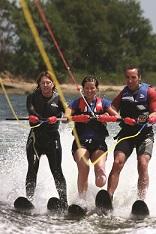
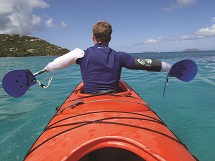
That’s a lot of people on water, and it doesn’t even take into account America’s 3.5 million miles of rivers[3] and countless miles of smaller-lake shoreline or the hundreds of thousands of us who travel to water. What does all that amount to? A lot of ways to enjoy all that H20.
BY BOAT
Joe Jacobi is CEO of US Canoe/Kayak (USA C/K), national governing body for Olympic sports flatwater sprint and whitewater slalom, the Paralympic sport of paracanoe, and the sanctioning body for a variety of paddle sports. But of all of USA C/K’s disciplines, stand-up paddleboard (SUP) is the one riding highest.
“There continues to be a lot of interest and growth in SUP, both recreationally and competitively,” says Jacobi. “The industry accommodates gear for different ability levels and types of water, giving consumers many choices and options.”
SUP has roots in many cultures across the globe, but one of its strongest centers of growth is believed to be among the ancient Hawaiians.[4] Over the last six years, the sport has worked its way west across North America, at first recreationally and then becoming increasingly competitive.[5] Now, Maine’s Lobster SUP Cup is bringing the sport to the continent’s farthest northeast reaches.
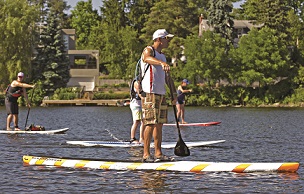
The Lobster SUP Cup director is Thor Emory, a race director who practices what he preaches. While in Hawaii preparing to race in the 32-mile Molokai-2-Oahu Paddleboard World Championships, he took time to share some information about the Lobster SUP Cup, his personal project.
“Our race is in its second year, and it’s still pretty small. But this year we hope to double it,” says Emory. “Our goal is to be a destination race, and that’s why we make it a fun, multi-day event. We also want to grow the event, so the big thing is to be realistic in the first couple of years and focus on running a clean event.”
A weekend-long party for SUPers in the picturesque community of Camden, Maine, the Lobster SUP Cup includes three days of clinics, social events and races of varying lengths. The whole event is a fundraiser for the Challenged Athletes Foundation’s (CAF) Operation Rebound program, which supports American military personnel, veterans and first responders with permanent physical disabilities.
Always Be Prepared
Any time a water sport event requires vessels—whether SUP, canoe, kayak, or even motorized boats— it adds an additional level of logistics, a challenge best addressed with a local, team approach.
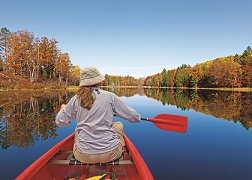
The Oceanside Outrigger Canoe Club (OOCC) is one such organization. A member of SCORA, the Southern California Outrigger Racing Association, OOCC helps create opportunities for athletes to participate in about a dozen events each summer and fall.
Building Better Access
When creating a water-sports-rich community, access is priceless. Many communities have built greenways—paths dedicated to running, walking and cycling. In Clarksville, Tennessee, there is now a path dedicated to those who want to ride the water. The Clarksville Blueway offers more than 100 miles (50 miles within city limits) of waterways with numerous access points throughout its multiple routes.
“The Blueway provides dedicated places to put in and take out, which makes it easier for boaters,” says Jessica Goldberg, director of tourism, Clarksville/Montgomery County Economic Development Council. “We also have lots of outfitters in the community to provide kayaks, canoes and so on, as well as to provide transportation, although you can also do a round trip!”
BY TRI
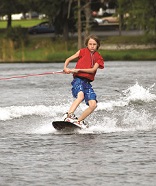 All over America, new triathlons pop up every year and existing races show growing numbers. In fact, USA Triathlon, the sport’s NGB, reported record growth among, coaches, race directors, officials and triathlon clubs in 2013.[6] Given the promising future of this sport, a look at its first—and potentially most logistically challenging—phase, the water race, is warranted.
All over America, new triathlons pop up every year and existing races show growing numbers. In fact, USA Triathlon, the sport’s NGB, reported record growth among, coaches, race directors, officials and triathlon clubs in 2013.[6] Given the promising future of this sport, a look at its first—and potentially most logistically challenging—phase, the water race, is warranted.
“A crucial part of tri planning, particularly for the swimming, is to work with a destination that has very good relationships with all of the agencies necessary,” says Ross Summers, president and CEO, Branson/Lakes Area Chamber of Commerce & CVB. “The Ironman 70.3 Branson requires a community effort and the cooperation of our citizens, the police, highway patrol, fire and safety personnel.”
Offer Options
Nicole Cueno, endurance sports coordinator, YWCA of Minneapolis, is also race director of the YWCA Women’s Triathlon, a race that offers its participants options for the swimming phase.
“Some races have moved to starting the race by time trial, but we’re continuing wave starts,” says Cueno. “We stayed with that because we keep our waves pretty small, and many of our racers are beginners. The swimming start isn’t as intimidating, with fewer aggressive swimmers.”
By using a wave start, the YWCA is also able to offer its athletes options. The elite wave goes first, but after that, women have the chance to choose between two wave options: a buddy wave, which allows racers to begin with their friends and an age group wave.
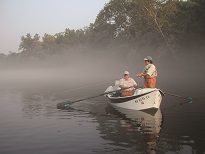
BY ROPE
Despite declining recreational participation, water skiing as a competitive sport is holding its own, says Bob Crowley, executive director, USA Water Ski. In fact, the competitive side of the sport is preparing for the largest three-event water ski tournament in the world: the 72nd GOODE Water Ski National Championships, which will take place in San Marcos, Texas. The event will draw 600-800 competitors, all of whom qualified at regional events. Show Ski is such a popular sport that its national championships require a venue that seats 4,000: Taxler Park in Janesville, Wisconsin. This August, the Janesville Rock Aqua Jays, the city’s local team, and the Janesville Convention and Visitors Bureau hosted the national championships for a second time.
“Show Ski has such a great community feeling,” says Crowley. “Janesville’s Rock Aqua Jays are one of the best teams in the world, and they share their knowledge. In fact, some folks from Janesville have even gone over to China to help develop a team there.”
Wake surfing is another of USA Water Ski’s disciplines that is riding high, says Crowley. “Technically, there’s no rope, but it’s considered a towed sport because the surfer rides waves that are created by the boat.”
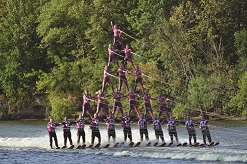
BY ROD
For some people, the only way to truly enjoy water is to spend a few hours angling for their next big catch. Fortunately, there are plenty of destinations with ample and beautiful fishing, all ready for the next big tournament.
Branson, Missouri, surrounded by lakes, is one of those destinations. Branson is a regular home to FLW (Fishing League Worldwide) events and this year, welcomed the Bassmaster Elite series, high-profile, televised events that bring business to Branson.
“We find [fishing has] a very loyal audience, and these events give people an idea of how beautiful Branson is,” says Summers. “People see these shows, and then they come fish here.”
Clarksville, Tennessee, is another picturesque destination with a big fishing reputation. “We sit at the convergence of two major rivers, the Cumberland and Red Rivers, and there are a lot of other smaller forks nearby,” says Goldberg. “Fishermen like the area because it’s easy to fish both Tennessee and Kentucky. You don’t have to spend a lot of time boating because we’re right in the middle.”

“We host lots of fishing tournaments, in particular because of our huge population of fish,” says Wendy Scott, sports sales manager, Great Lakes Bay Regional Convention and Visitors Bureau. “In Great Lakes Bay, you’ll find more than three million walleye.”
Walleye tournaments abound in the spring, but in Michigan, fishing is a year-round sport. Some of the biggest purses in the region go to the winners of the region’s ice fishing tournaments.
BY WAVE
The city of Flagler Beach, Florida, has a swell report on the home page of its website and for good reason. With 19 miles of beaches and a dependable swell, the “quiet side of Florida,” as the town calls itself, delivers serious surf.
“One of our biggest events is the Tommy Tant Memorial Surf Classic,” says Matthew Dunn, vice president, Flagler County Chamber of Commerce. “It was started by Tommy’s brother Will as a memorial after Tommy died of an aneurysm. Both brothers were surfers, and Will is now a model for Nautica, who sponsors the event.”
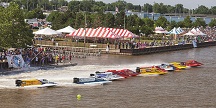
Where There’s a Will, There’s a Wave
When you don’t have natural surf, one way to create one is with a boat. In Oklahoma City, they also do it by cable.
“Wakezone, our cable wakeboarding park, gets bigger every year, adding jumps and stunts and more events,” says Sue Hollenbeck, director of sports business, Oklahoma City Convention and Visitors Bureau. “It’s definitely a growing sport. You don’t need a boat—just a cable—and you can do it at any skill level, beginner up to expert.”
THE BEST EVENT, BY LAND OR BY SEA
Water sports for everyone is an important part of the sports world, and being prepared to include athletes of all abilities is part of being a well-prepared event owner.
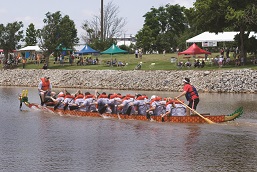
Accessible venues and event-management training for adaptive athletes are also important to these events. Fortunately, information and opportunities abound, usually provided by each sport’s NGB.
Pensacola, Florida, is another destination that is virtually swimming in sports events, from fishing to SUP and everything in between. Having seen an array of sports events—and planned his fair share as well—Ray Palmer, executive director, Pensacola Sports Association, has some advice: “Don’t try to over-manage events that are already being managed well. We have a great staff and offer whatever help our events need. But when they’re running a successful event, we also work hard to stay out of their way.”
[1] http://oceanservice.noaa.gov/facts/population.html.
[2] http://www.epa.gov/greatlakes/factsheet.html.
[3] http://www.americanrivers.org/rivers/about/
[4] http://standupjournal.com/the-history-of-stand-up-paddle-boarding/
[5] Via Thor Emory: SUP in its current form was really developed by Laird Hamilton, Dave Kalama, and a few others Hawaiian big wave surfers who started playing around with it during the summer when the waves were smaller.
[6] http://www.usatriathlon.org/about-multisport/demographics.aspx

